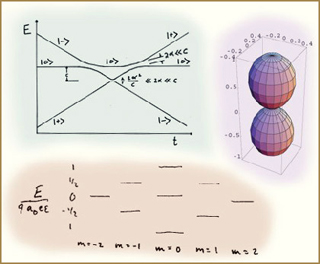Course Description
Together, this course and its predecessor, 8.05: Quantum Physics II, cover quantum physics with applications drawn from modern physics. Topics in this course include units, time-independent approximation methods, the structure of one- and two-electron atoms, charged particles in a magnetic field, scattering, and …
Together, this course and its predecessor, 8.05: Quantum Physics II, cover quantum physics with applications drawn from modern physics. Topics in this course include units, time-independent approximation methods, the structure of one- and two-electron atoms, charged particles in a magnetic field, scattering, and time-dependent perturbation theory. In this second term, students are required to research and write a paper on a topic related to the content of 8.05 and 8.06.
Course Info
Instructor
Departments
Topics
Learning Resource Types
group_work
Projects
assignment
Problem Sets

Energy levels in a certain time-dependent three state system with two off-diagonal matrix elements α and the third zero, a spherical harmonic, and the Stark effect for n=3. (Image by Prof. Krishna Rajagopal.)










